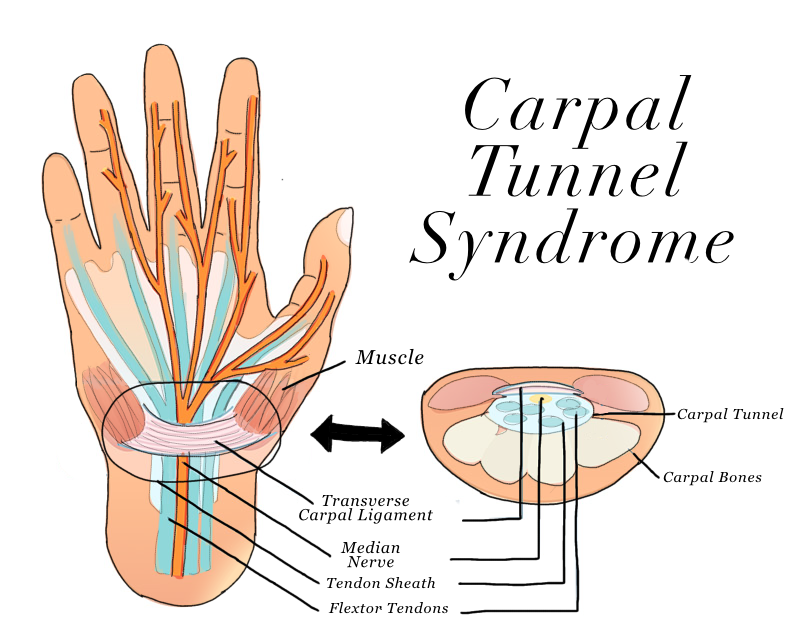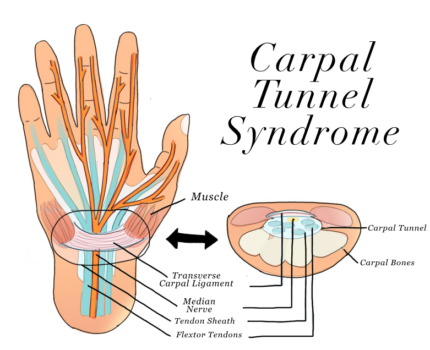Carpal Tunnel Syndrome (CTS)
–
The topic I chose to research was carpal tunnel syndrome (CTS), a condition caused by the compression of the median nerve as it passes through the carpal tunnel. This topic relates to the class objective from unit 4: “Describe the structure and function of peripheral nerves, including common disorders that affect them.” Carpal Tunnel Syndrome occurs when the space in the carpal tunnel located at the wrist becomes restricted due to swelling, repetitive motion, and or injury. As shown in the masterpiece I’ve made the carpal tunnel is a narrow passageway formed by the carpal bones on the bottom and the transverse carpal ligament on top. Inside this tunnel are the median nerve and flexor tendons that control finger movement, so how I am typing this… When the tendons become inflamed or the tunnel narrows the median nerve compresses and leads to symptoms like numbness, tingling and pain in the dumb index and middle fingers. Over time, muscles weakens and difficulty with grip strength developes, particularly if left untreated. The photo highlights the key structures involved: the transverse carpal ligament, this acts as the roof of the tunnel; median nerve which is responsible for sensation and motor control in parts of the hand and flexor tendons which facilitate finger movement. Compression of the median nerve disrupts its ability to send and receive signals, this causes symptoms that often begin gradually such as tingling during or after repetitive wrist movements from typing-
A study on ergonomic interventions found that workers who adjusted their workstation setup wore wrist supporters, and practiced stretching exercises were 43% less like to develop CTS symptoms (Gupta A “Workplace ergonomics and its role in carpal tunnel syndrome prevention”) Early treatment is crucial to avoid long term damage. Initial treatments often include wrist splints which keep the wrist in a neutral position and corticosteroid injections to reduce inflammation. In severe cases surgery may be nectary to release the transverse carpal ligament and relieve pressure on the median nerve.
For my project, I created a diagram. It includes labeled structures such as the transverse carpal ligament, carpal bones, median nerve, and flexor tendons. The model also demonstrates how swelling or compression in the tunnel affects the median nerve. This visual representation helps illustrate importance of prevention and early intervention.

Sources: (Updated as of 12/05/24)
Rotaru-Zavaleanu A-D, Lungulescu CV, Bunescu MG, Vasile RC, Gheorman V, Gresita A and Dinescu VC (2024) Occupational Carpal Tunnel Syndrome: a scoping review of causes, mechanisms, diagnosis, and intervention strategies. Front. Public Health. 12:1407302. doi: 10.3389/fpubh.2024.1407302
Genova, A., Dix, O., Saefan, A., Thakur, M., & Hassan, A. (2020). Carpal Tunnel Syndrome: A Review of Literature. Cureus, 12(3), e7333
OpenStax. (2024). Human Anatomy and Physiology.



In her project, Natasha delves into Carpal Tunnel Syndrome (CTS), a condition caused by the compression of the median nerve within the wrist’s carpal tunnel. This research aligns perfectly with the goals of the anatomy class, focusing on understanding peripheral nerves and their related disorders. Natasha explains that CTS develops when swelling, repetitive motions, or injuries constrict the carpal tunnel, which is formed by the carpal bones and the transverse carpal ligament. She highlights the crucial anatomy involved, including the median nerve, which is responsible for sensation and motor function in the hand, as well as the flexor tendons that aid in finger movement.
She points out that symptoms of CTS—such as numbness, tingling, and pain in the thumb, index, and middle fingers—can become more severe if not treated, potentially leading to muscle weakness and difficulty gripping objects. Moreover, Natasha underscores the importance of ergonomic adjustments, citing a study showing that modified workstations and preventative measures resulted in a 43% reduction in CTS symptoms among employees. Treatment options available vary from wearing wrist splints and receiving corticosteroid injections to surgical release of the transverse carpal ligament in more severe cases. To illustrate her findings, Natasha crafted a labelled diagram that highlights the key anatomical structures involved in CTS, clearly showing how swelling impacts the median nerve. This visual aid emphasizes the critical role of prevention and early intervention in effectively managing Carpal Tunnel Syndrome.